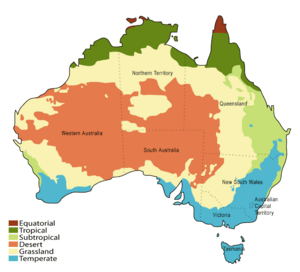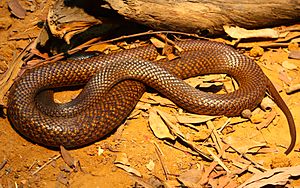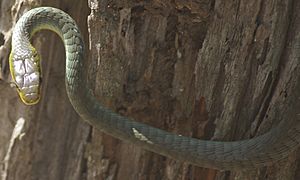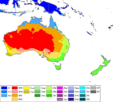Australian snake habitats facts for kids
Australia is a huge country, covering about 7.6 million square kilometres! Because it's so big, Australia has many different climates. These include hot equatorial areas, tropical zones, dry deserts, and even cooler temperate and alpine (mountain) regions. All these different climates create unique homes for Australia's many types of snakes, influencing where they live and how many there are.
Contents
Western Australia
Most of Western Australia is desert or semi-arid. This means it gets very little rain, often less than a foot all year. The soil isn't very rich, and it's sunny for more than half the year. This hot, dry environment is home to many different snakes.
Temperatures here can be very high, often in the 30s and 40s degrees Celsius for much of the year. Snakes love these hot temperatures because they are poikilothermic. This means they can't control their own body temperature. Instead, they rely on outside heat sources, like the sun, to stay warm. You'll often find them basking on rocks or sandy desert areas. Some snakes also live in grassy areas near wetlands and lakes in the cooler southwest part of the state.
Northern Territory
The Northern Territory is located northeast of Western Australia. Its climate varies a lot, from desert in the south to tropical in the north. This wide range of climates means you'll find many different kinds of snakes here. Temperatures average around 26 degrees Celsius all year. The further south you go, the cooler it gets, with some desert areas even reaching below freezing.
The MacLeay's water snake is a good example of a snake found in the coastal Northern Territory. These snakes are mostly active at night. They spend most of their time in or near water, like freshwater lagoons, swamps, and creeks, where they hunt for food. They only leave the water to warm up in the sun or to have babies. During the wet season, when there's a lot of flooding, they can spread out more. These snakes have thick bodies and rough scales. They are viviparous, which means they give birth to live babies (up to 15 at a time) instead of laying eggs. They have mild venom and fangs at the back of their mouths.
Queensland
Queensland is on Australia's east coast and is the second-largest state. Its huge size means it has many different climates. The coastal areas are very humid and warm all year. Inland, you'll find mostly grasslands. Most of Queensland's snakes live in the northern part of the state. This area has tropical rainforests, which offer lots of plants for snakes to hide in and many animals for them to eat. Snakes also live in natural caves and soft soil near cliffs, where they can find sunny rocks to warm up on. Some snakes can even dig into the soil.
The Eastern brown snake is a well-known species found in Queensland. It's named for its usual brown color, though it can also be tan, grey, or dark brown. Its belly is usually cream, yellow, or pale orange with darker spots. This snake is part of the cobra family. It's slender, has a small head, and is very alert, fast, and highly venomous. Eastern brown snakes are active during the day, hunting small lizards, mice, and ground-dwelling birds.
South Australia
To the south of the Northern Territory is South Australia. This state has a mostly temperate climate with some desert areas. Sand dunes are common places where snakes in this region have their babies. Many venomous snakes live here because the area gets plenty of sun but also offers enough places for them to hide.
The Tiger snake is a famous species found in South Australia. They often have striped patterns, which gives them their name. These stripes can change with the seasons and as the snake gets older. Tiger snakes are very territorial, meaning they often stay in the same spot for many years. You can find them in many different places, even in suburbs. Because they are territorial, they don't move around much. They eat all sorts of creatures, including frogs, small fish, and other small mammals.
New South Wales
New South Wales (NSW) is on the central east coast of Australia. It surrounds the Australian Capital Territory, where Australia's capital city, Canberra, is located. Most of NSW has a temperate climate. This climate isn't ideal for snakes that need long periods of heat to survive. NSW also has large mountain ranges where it snows in winter. Snakes are not found in these snowy regions. They are most common in the rural bushland, which has areas of farms and natural vegetation.
The Common Tree Snake is found in several Australian states, including New South Wales. These snakes have a unique way of moving: they can stiffen their bodies like a beam to cross from one tree branch to another. They often hide among vines, like ivy, where their colors help them blend in with their surroundings. They have a tiny head and thin front parts, but they can grow up to 1.8 metres long! They hunt birds, lizards that live in trees, and frogs.
Victoria
Victoria has a temperate climate and a large coastal area. There are fewer snakes here compared to warmer states because snakes prefer sunny, warm places where they can bask. As poikilothermic animals, they rely heavily on outside heat to survive.
The white-lipped snake is one of the few snake species that can live in the cold highland regions of Victoria. It prefers to live in tussock grass or sedge fields, where this small snake finds shelter under logs or thick plants. It's amazing that this snake lays eggs (is oviparous) in such a cold habitat. Its small size and secretive habits likely help it survive these tough conditions. While the cold doesn't harm the snake's eggs much, it does affect how often they reproduce, limiting them to every 2 to 3 years.
Images for kids
See Also
- “Snakes”. NSW Government. 17 /Feb 2011. http://www.environment.nsw.gov.au/animals/snakes.htm>





